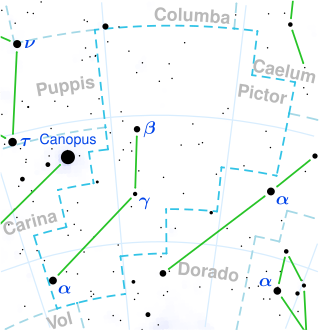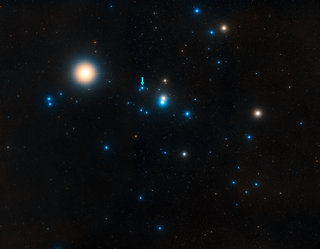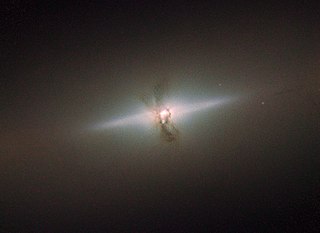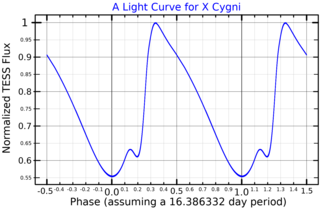The following table lists polar-ring galaxies:
The following table lists polar-ring galaxies:
| Image | Galaxy | Base galaxy type | Notes |
|---|---|---|---|
 | NGC 2685 (UGC 4666, Arp 336, Helix Galaxy) | Lenticular (S0) | [1] [2] |
 | NGC 4650A (ESO 322-IG69, AM 1241-402) | Lenticular (S0) | [2] [3] [4] |
 | NGC 660 | Lenticular (S0) or Barred Spiral (SBa) | |
| A0136-0801 | Lenticular (S0) | [2] [5] | |
| AM 1934-563 | Barred Spiral (SBa/b) | [6] | |
| ESO 415-G26 (AM 0226-320) | Lenticular (S0) | [2] [4] | |
| UGC 5119 (LEDA 27383) | Elliptical | [7] | |
| UGC 7576 | Lenticular (S0) | [2] | |
 | UGC 9796 (II Zwicky 73) | Lenticular (S0) | [2] |
| AM 2020-504 | Elliptical | [2] | |
Some galaxies feature a "polar ring" within the disk of the galaxy:

Hoag's Object is an unusual ring galaxy in the constellation of Serpens Caput. It is named after Arthur Hoag, who discovered it in 1950 and identified it as either a planetary nebula or a peculiar galaxy. The galaxy has a D25 isophotal diameter of 45.41 kiloparsecs (148,000 light-years).

Messier 87 is a supergiant elliptical galaxy in the constellation Virgo that contains several trillion stars. One of the largest and most massive galaxies in the local universe, it has a large population of globular clusters—about 15,000 compared with the 150–200 orbiting the Milky Way—and a jet of energetic plasma that originates at the core and extends at least 1,500 parsecs, traveling at a relativistic speed. It is one of the brightest radio sources in the sky and a popular target for both amateur and professional astronomers.

The Sombrero Galaxy is a peculiar galaxy of unclear classification in the constellation borders of Virgo and Corvus, being about 9.55 megaparsecs from the Milky Way galaxy. It is a member of the Virgo II Groups, a series of galaxies and galaxy clusters strung out from the southern edge of the Virgo Supercluster. It has an isophotal diameter of approximately 29.09 to 32.32 kiloparsecs, making it slightly bigger in size than the Milky Way.

Messier 32 is a dwarf "early-type" galaxy about 2,650,000 light-years (810,000 pc) from the Solar System, appearing in the constellation Andromeda. M32 is a satellite galaxy of the Andromeda Galaxy (M31) and was discovered by Guillaume Le Gentil in 1749.
27 Cancri is a single star in the zodiac constellation of Cancer, located around 990 light-years away from the Sun. It is visible to the naked eye as a faint, red-hued star with a typical apparent visual magnitude of around +5.56. The star is moving closer to the Earth with a heliocentric radial velocity of −8.3 km/s. It is a member of the Arcturus stream, a group of stars with high proper motion and metal-poor properties thought to be the remnants of a small galaxy consumed by the Milky Way.

A polar-ring galaxy is a type of galaxy with an outer ring of gas and stars that rotates over the poles of the galaxy. These polar rings are thought to form when two galaxies gravitationally interact with each other. One possibility is that a material is tidally stripped from a passing galaxy to produce the polar ring. The other possibility is that a smaller galaxy collides orthogonally with the plane of rotation of the larger galaxy, with the smaller galaxy effectively forming the polar-ring structure.

NGC 4650A is a polar-ring lenticular galaxy located in the constellation Centaurus. It should not be confused with the spiral galaxy NGC 4650, which shares almost the same radial distance as NGC 4650A. The real distance between both galaxies is only about 6 times the optical radius of NGC 4650.

V352 Aurigae is a variable star in the northern constellation of Auriga. It dimly visible to the naked eye with an apparent visual magnitude that ranges from 6.13 down to 6.18. According to the Bortle scale, it is faintly visible to the naked eye from dark rural skies. The star is located at a distance of approximately 970 light years from the Sun based on parallax, but is drifting closer with a radial velocity of −7 km/s.

Epsilon Piscis Austrini, Latinized from ε Piscis Austrini, is a blue-white hued star in the southern constellation of Piscis Austrinus. It is visible to the naked eye with an apparent visual magnitude of +4.17. Based upon an annual parallax shift of 8.0981 ± 0.3582 mas as seen from the GAIA satellite, the system is located roughly 400 light years from the Sun.

Delta Pictoris, Latinized from δ Pictoris, is a binary star system in the southern constellation Pictor. It is visible to the naked with a combined apparent visual magnitude of 4.72. The system is located at a distance of approximately 1,300 light years from the Sun based on parallax measurements, and is drifting further away with a radial velocity of ~31 km/s. It is a runaway star system that is generating a bow shock as it moves through the interstellar medium.

HD 28527 is a star in the constellation Taurus, and a member of the Hyades open cluster. It is faintly visible to the naked eye with an apparent visual magnitude of 4.78. The distance to this star, as determined from its parallax shift of 22 mas, is 148 light years. It is moving away from the Earth with a heliocentric radial velocity of +38 km/s.

UGC 9796 is a lenticular and polar-ring galaxy in the constellation Boötes, and about 250 million light years distant from Earth. It is an object of great scientific interest as there have been very few polar ring galaxies discovered. UGC 9796 is a very gas-rich environment hosting as much 5×109 solar masses of neutral hydrogen. DSS and SDSS images show that it is very similar to polar ring galaxy NGC 660, the best-known of all the polar ring galaxies.

NGC 2748 is a spiral galaxy in the northern circumpolar constellation of Camelopardalis, located at a distance of 61.3 megalight-years from the Milky Way. It was discovered September 2, 1828 by John Herschel. The morphological classification of SAbc indicates this is an unbarred spiral with moderate to loosely-wound spiral arms. It is a disk-like peculiar galaxy with a stellar shell that is rotating about the main galactic axis. This shell was most likely formed through the capture and disruption of a dwarf companion. The galactic nucleus likely contains a supermassive black hole with a mass of 4.4+3.5
−3.6×107 M☉, or 44 million times the mass of the Sun.

NGC 4111 is a lenticular galaxy in the constellation Canes Venatici. It is located at a distance of circa 50 million light-years from Earth, which, given its apparent dimensions, means that NGC 4111 is about 55,000 light-years across. It was discovered by William Herschel in 1788. NGC 4111 possesses both thin and thick discs.

NGC 2273 is a barred spiral galaxy located in the constellation Lynx. It is located at a distance of circa 95 million light years from Earth, which, given its apparent dimensions, means that NGC 2273 is about 100,000 light years across. It was discovered by Nils Dunér on September 15, 1867.

HD 93521 is a single, massive star in the northern constellation of Leo Minor. With an apparent visual magnitude of 7.03, it is too faint to be seen with the naked eye. The star is located at a distance of approximately 5.0 kilolight-years (1.52 kpc) from the Sun based on parallax measurements. It is positioned at a high galactic latitude of +62° and is located about 4.6 kilolight-years (1.4 kpc) above the Galactic plane.

EU Tauri is a variable star in the equatorial constellation of Taurus. With a brightness that cycles around an apparent visual magnitude of 8.07, it is too faint to be visible to the naked eye. The distance to this star is approximately 3,900 light years based on parallax measurements, but it is drifting closer with a radial velocity of −2.5 km/s. The position of this star near the ecliptic means it is subject to lunar occultations.

X Cygni is a variable star in the northern constellation of Cygnus, abbreviated X Cyg. This is a Delta Cephei variable that ranges in brightness from an apparent visual magnitude of 5.85 down to 6.91 with a period of 16.386332 days. At it brightest, this star is dimly visible to the naked eye. The distance to this star is approximately 628 light years based on parallax measurements. It is drifting further away with a radial velocity of 8.1 km/s. This star is a likely member of the open cluster Ruprecht 173.

NGC 7625, or Arp 212, is a peculiar galaxy in the constellation of Pegasus. It was discovered on October 15, 1784, by William Herschel. In his New General Catalogue (1888), J. L. E. Dreyer described it as pretty bright, considerably small, round, with a suddenly much brighter middle. It is located at an estimated distance of 78 million light-years from the Milky Way galaxy.

NGC 5953 is a peculiar spiral galaxy in the constellation Serpens. The galaxy lies about 80 million light years away from Earth, which means, given its apparent dimensions, that NGC 5953 is approximately 35,000 light years across. It was discovered by William Herschel on April 17, 1784. NGC 5953 interacts with NGC 5954 forming a pair known as Arp 91.